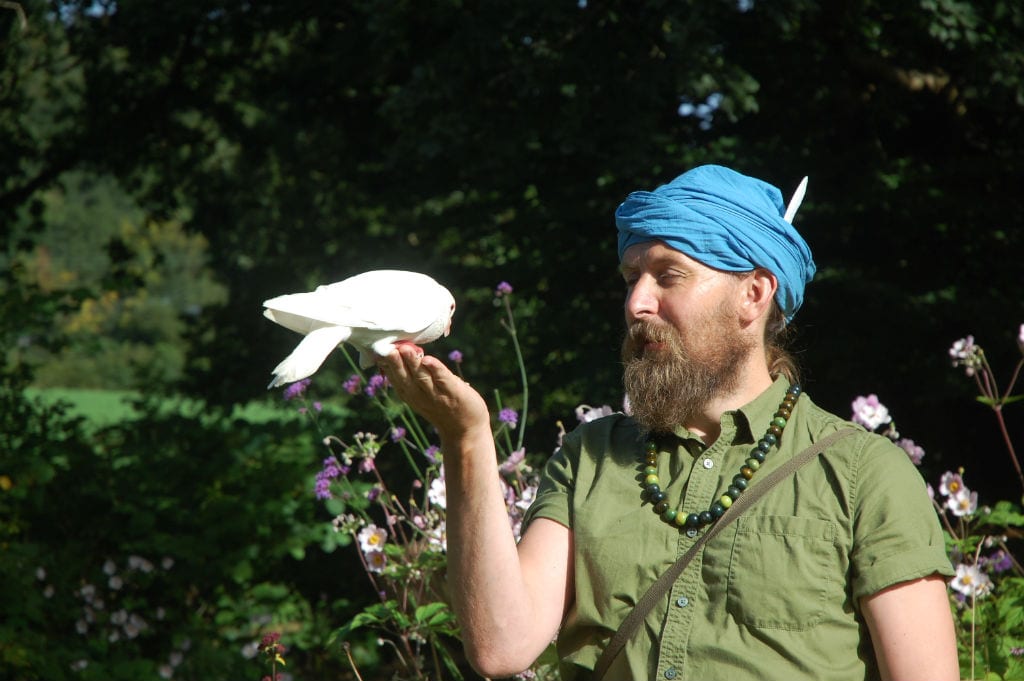I Am a Tree is a show by Jamie Wood about man’s relationship with nature. It is a self-portrait of Jamie as an earth-loving nomad who refuses to yield to modern urbanity. He absorbs information like a tree taking in water through its roots: the family, friends and strangers whom he interacts with all shape his growth. Jamie is caught between worlds as he fondly remembers the sounds of chirping birds, but also recalls the drone of cars driving through London. It is a show about a man trying to maintain a close relationship with nature, even when the hustle and bustle of the city threatens to take that away.
Jamie immediately demonstrates a fondness for his audience. Over the course of the evening he picks out random (and somewhat unwilling) people and beckons them onto the stage for assistance. One bursts a balloon full of confetti over his head with a blowpipe, another few pretend to be trees and another emulates animals, in this case a peacock and a giraffe. It is amusing to the fellow audience members to see this clowning, but these assistants are eventually rewarded when they each win a trophy of broccoli – as Jamie says, ‘We are all trees’. Jamie also has a penchant for hugging these assistants, who were previously strangers, which helps establish the collaborative energy of I Am a Tree; the show is as much about how the audience responds to Jamie’s story as the story itself. Jamie proclaims that he adores strangers and draws strength from them: he has a happy memory of a sea of strangers’ faces, which met him when he incandescently walked outside after the birth of his child; this was a time when the world was pregnant with possibility.
There is a peaceful energy in the show as Jamie’s memories slide into focus. Jamie confesses that he was much closer to his grandad that his dad. He wants to find his grandad’s ‘noise’ – his soul – and perhaps the answer, which is part of that eternal question about posthumous transformation, lies dormant in the surrounding topography. Jamie accesses the wonder of nature in several ways: he takes an exquisite pleasure in eating a plum, which is a way for him to directly communicate with the vast natural world. He also performs a salutation to the north, south, east and west as a way to express gratitude to the earth for its existence. Intricately hidden in Jamie’s nest of hair is a plastic bottle containing fake hallucinogens – pieces of raisin – that are dished out to chosen audience members. The whole experience of I Am a Tree is designed to be ecstatically spiritual in its appreciation of how ancient the world is.
Jamie encourages his assistants to freely express themselves. He draws attention to the similarity of ‘will’ to ‘wild’ as one of the assistants in this performance threw out this sentence when asked his opinion of this show, albeit slightly uncomfortably under the spotlight: ‘Why don’t I do this more often?’ Jamie keenly reworked this sentence with inflection as he gestures to the air: ‘What do you mean by this?’ he enquires. The druid-like Jamie enjoys this response because it highlights the intentional weirdness of his show.
I Am a Tree resists categorisation: is it theatre or therapy? Regardless of the nomenclature, the show succeeds in creating an atmosphere of relaxation and reflection. The Omnitorium is a compact venue, but it has an aura of mysticism that perfectly complements the show and its subject matter.

4
Reviewer's Rating
